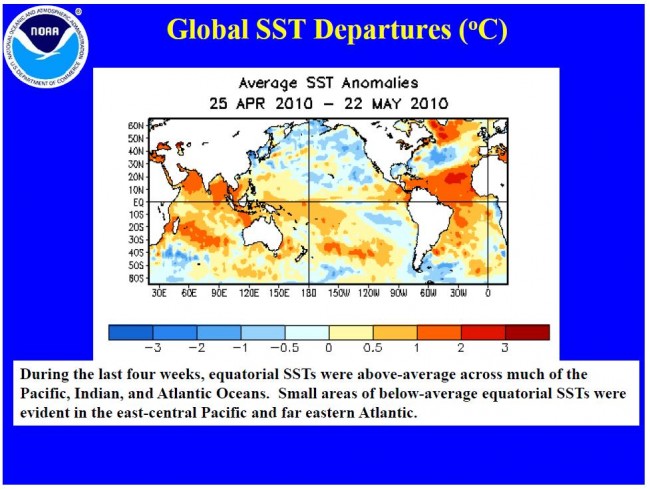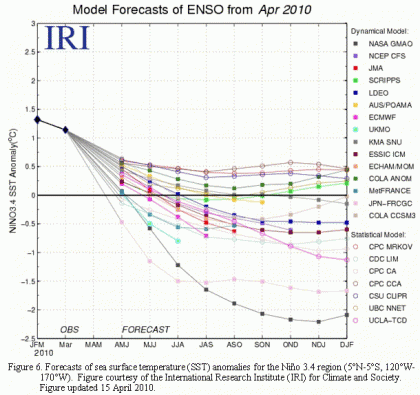26 May 2010
Open Season On Hurricanes (and they may be in a fighting mood.)
Posted by Dan Satterfield

From NOAA- The El Nino is fading away in the Pacific but Atlantic sea surface temps. are near record levels. Both of these factors argue for an active hurricane season in the Atlantic.
Hurricane season begins June 1st and NOAA’s hurricane experts will release their 2010 season forecast Friday 28 May. It’s not much of a secret among meteorologists what it will be.
Likely BAD.
Forecasting the number of hurricanes we will see each year is a very tricky project. There is some skill but changes in the sea surface temperatures and in the upper level wind shear during the summer months make any forecast iffy.
So, that said here is why NOAA will forecast an increased number of hurricanes this year.
THE AMO:
The Atlantic Multi-Decadal Oscillation is an ocean atmosphere oscillation that runs in 10-30 year cycles. It causes warmer than normal waters in the main development region and favorable winds for more hurricanes. (On top of changes caused by increasing greenhouse gases). The AMO cycle has been favorable for above average hurricane seasons since the mid 1990’s.

Models are forecasting El Nino to quickly die and an increasing possibility of a La Nina. La Nina's cause more hurricanes. Just the opposite of El Nino's.
EL NINO:
Last winter’s El Nino is now rapidly disappearing. The warmer than normal waters in the Equatorial Pacific have almost disappeared and virtually all of the models are forecasting a return to either neutral or even La Nina conditions by the end of summer.
El Nino’s in the Pacific produce a weather pattern in the Atlantic that causes increased wind shear. This usually means fewer hurricanes. La Nina’s produce lower wind shear in the Atlantic and are associated with more active seasons.
SEA SURFACE TEMPS:
The oceans worldwide are the warmest ever measured right now. There are very strong indications this is due to the increasing greenhouse gases in the atmosphere. The record warmth in the Atlantic is likely caused the AMO discussed above and the Arctic Oscillation.
This is the same pattern of atmospheric pressure that was responsible for the cold and snowy winter in the UK and the Eastern USA. It also causes warm waters to spread over the main development region for hurricanes in the Atlantic.
You add up all of this and you get very good odds for an active season. Keep in mind that the Arctic Oscillation may change and sea water temps could cool. El Nino may hang on longer than expected too. If this happens we could see a normal season, or even below.
The odds however say otherwise.
Dan
PS There is some fascinating new science in one of the great questions of meteorology. Will we see more or fewer hurricanes in the warmer World of the late 21st century?? I will have that post soon. I’m still reading the papers…



 Dan Satterfield has worked as an on air meteorologist for 32 years in Oklahoma, Florida and Alabama. Forecasting weather is Dan's job, but all of Earth Science is his passion. This journal is where Dan writes about things he has too little time for on air. Dan blogs about peer-reviewed Earth science for Junior High level audiences and up.
Dan Satterfield has worked as an on air meteorologist for 32 years in Oklahoma, Florida and Alabama. Forecasting weather is Dan's job, but all of Earth Science is his passion. This journal is where Dan writes about things he has too little time for on air. Dan blogs about peer-reviewed Earth science for Junior High level audiences and up.
[…] Click Here to Read Full Story Categorized in Hurricanes Tags: 2010 Atlantic Hurricane Season, hurricane, hurricane season, Hurricanes addthis_url = 'http%3A%2F%2Fhurricane-katrina.org%2F2010%2F05%2Fdans-wild-wild-science-journal-%25c2%25bb-blog-archive-%25c2%25bb-open-season-on.html '; addthis_title = 'Dan’s Wild Wild Science Journal » Blog Archive » Open Season On …'; addthis_pub = ''; […]